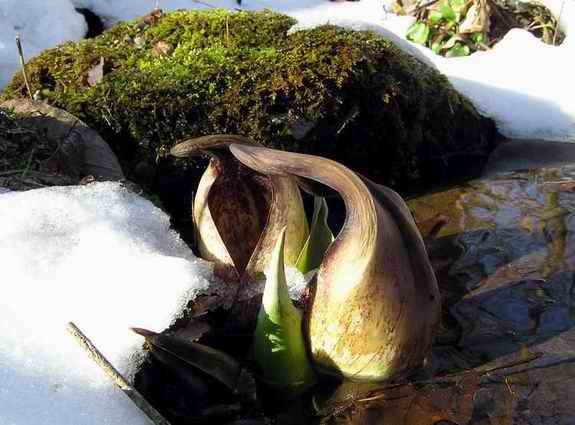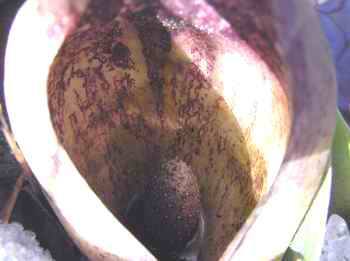|
Return to Hiker's Notebook Home Page Common Name: Skunk Cabbage, Clumpfoot Cabbage, Swamp Lantern, Polecat Weed Scientific Name: Symplocarpus foetidus (Genus from Greek symploke meaning connected and karpos meaning fruit which refers to fact that the flowering stalk called a spadix consists of tightly packed fruits; foetidus means foul smelling in Latin from which the adjective fetid is also derived)
The skunk cabbage is among the first plants to emerge in the yearly deciduous cycle; so early that it starts growing well before the warmer temperatures of spring. It is able to do this through a process of heat generation known as thermogenesis. During the summer growing season, the large leaves of the plant convert carbon dioxide to starch that is stored in the large rhizome, or root. Toward the end of the subsequent winter, the process is reversed, and it uses the oxygen in the air to oxidize the starches to generate heat.
The heat is used to maintain the temperature inside the hood-like leafy covering called the spathe that surrounds the spadix flower in the center at about 20 degrees Celsius. Experiments have shown that when the ambient temperature is 15 degrees C, it is 24 degrees inside the spathe. When the temperature drops to - 15 degrees C, the skunk cabbage maintains the temperature at a moderate + 15 degrees C. It is theorized that the mechanism that the skunk cabbage uses to regulate the temperature is a combination of an enzyme called alternative oxidase (AOX), present only in plants and uncoupling proteins (UCPs), the heat generating agents for mammals. The mechanism, called the "skunk cabbage algorithm" is being evaluated for use as a controller for air conditioners.
The production of heat by plants of the Arum family, of which skunk cabbage is a member (others are Jack-in-the-Pulpit and some Philadendrons), raises questions among biologists as to what the benefit is to the plant. The heat is generated for about two weeks and uses as much oxygen as would a mammal of similar size. One theory is that the heat attracts insects to the warmth of the pocket inside the spathe that holds the spadix flower, thus winning the competition for pollinators. The dearth of heat producing plants in favor of flowers that produce nectar suggests that the latter is a better strategy, as the pollinators must go from flower to flower, spreading the pollen more effectively.
The second reason postulated for the heat is that it triggers and spreads the plant's characteristic aroma. The skunk cabbage is named for its pungent smell, which is similar to that of rotting flesh. This is because the skunk cabbage releases the same volatile organic compounds created when microorganisms consume rotting flesh, notably putrescine and cadavarine (putrid cadaver). This verisimilitude is further advanced by the brown mottled spathe that looks like meat. The combination attracts carrion flies which are among the very few pollinators in early spring when the skunk cabbage first emerges. Some members of the Arum family have a sequenced fertilization process that takes advantage of the heated area contained by the spathe around the fleshy spike of tiny flowers called the spadix. Pollinators are attracted to the smell and enter the spathe, where they are drawn to the region of female flowers at the bottom to fertilize them. Only after this occurs do the male flowers near the top open to drop pollen on the insects, which then spread it to other plants, the whole process being timed to prevent self-pollination.
The skunk cabbage is a perennial plant with a well established root system that consists of a vertical rhizome that can extend up to 2 feet into the ground with a mass of roots radiating in all directions. The roots are unusual in that they have circumferential ridges at regular intervals that contract to pull the plant down into the ground every spring so that the stems and leaves stay at ground level. The root structures are virtually indestructible, save by loss of the swampy habitat, and can be hundreds of years old.
Skunk cabbage produces the chemical calcium oxalate that is considered toxic and can cause a burning sensation when ingested. However, it was widely used by Native Americans in small doses and after the leaves had been dried sufficiently to reduce the toxicity. They used it as a poultice to heal skin wounds and inhaled the vapors from crushed leaves to cure headaches. Early colonists considered it a contraceptive, believing that one tablespoon three times a day for three weeks would cause sterility. It was listed in the United States Pharmacopoeia from 1820 to 1882 and was used as a treatment for a wide variety of ailments including asthma, epilepsy, spasmodic coughs, and rheumatism. |

